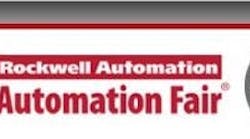"We've expanded the capabilities of The Connected Enterprise, but we're also simplifying it, so people can learn what it is and what it can do," said Elizabeth Parkinson, director of market development, The Connected Enterprise, Rockwell Automation, as we set off on a tour of the Innovation Zone, where Automation Fair attendees could get a glimpse of technologies and solutions under development at Rockwell Automation.
"We're also dividing our offering into functional areas, so people can use the ones they need, such as predictive maintenance, demand-driven manufacturing, recipe management, clean-in-place (CIP) and others,” Parkinson said. “To show users how to get started applying it, we've also made many functions scalable, such as analytics and manufacturing execution systems (MES), so users don't have to do an entire MES implementation to get started, and can instead take first steps from wherever they want."
Scalable Analytics
John Pritchard, global market development manager, Integrated Architecture, Rockwell Automation, reported that one of the company's most important new solutions is Scalable Analytics, which includes local analytics that run in its ControlLogix control systems.
"Users can define what the processor's function should be, and then it learns," said Pritchard. "If it's assigned to deal with incipient cavitation in a pump, then when it spots it, it can also take corrective action and slow the pump down. It does this using an algorithm that can look at whatever continuous variable it needs to, and then resulting data can be sent to the enterprise."
[sidebar id =1]"Previously, we had to write ladder logic or structured function block software to do these tasks,” added Michael Keller, systems architect and analytics director, Rockwell Automation. “Scalable analytics lets us add these functions to the regular controls, and then send data back to the operators or the system—and do it in real time, 20 milliseconds or less. This means we can produce and consume analytics closer to the process, and only send data that makes sense to the higher levels, which lets the customers decide how to use it best."
Virtual Design
Just as its MES and analytics tools are finding new formats and applications, the Studio 5000 environment from Rockwell Automation is being applied in new venues as well. Perhaps most intriguing is its latest manifestation on the Microsoft HoloLens augmented reality headset. This interface appears to suspend CAD images and designs—including animated ones—in space, allowing users to interact with them.
"This can shorten virtual design time, reduce commissioning, and allow more validation before building physical prototypes," said Bryan Siafakas, Studio 5000 product manager, Control and Visualization, Rockwell Automation.
Though the headset is potentially useful, Pritchard added that users can still employ their onscreen 3D design tools and connect to them in real-time to easily produce simulations. "Their physics can run on a ControlLogix 5580 controller or run virtually," explained Siafakas. "We use Studio 5000 for these animations, but we're also using Machineering GmbH's Industrial Physics software to link our Integrated Architecture to the 3D design world."
Beyond rendering machines and equipment, Siafakas said this 3D solution could simulate an entire plant with help from virtual links to other software providers, such as Mynah, Cape Software, MatLab and Machineering. "This can also allow operators to train in a safer environment," added Siafakas.
Application content
This aspect of the Rockwell Automation innovation strategy gathers together “starter” program elements such as control logic and faceplate designs to help users develop applications more quickly and efficiently. The new release of Studio 5000 as part of the firm's Application Code Manager will be launched in about a month, and it will include a library of this kind of application content.
"The point of this is to standardize software, so users don't have to customize code, and they can manage machine lifecycles and get them built faster," said Joachim Thomsen, senior manager of Application IP, Rockwell Automation. "This kind of software is written as a modular application, which means it can be abstracted, and used to upgrade hardware. The next step in Application Content is embedding Application Information Data Types into it, which is a feature of the Studio 5000 Application Code Manager. This also standardizes the way data in programs is served up, and makes data from machines easier to read because it's arranged hierarchically.”
Pritchard added that these efforts are intended to reduce labor for users, and give them a "zero-energy" path to the information they need. One new method for doing this was demonstrated at Automation Fair, where these data types were dropped into software on equipment on the show floor. "Once they're embedded, data types can be discovered by VantagePoint, and report back real-time data and event data," said Pritchard. "We still have to do some development, but we'll be able to make this solution available in a year or two."
Collaborative robotics integration
While the innovation exhibit mostly focused on software, it also showed how that software can get into some very heavy-duty hardware settings.
For example, "Enhanced Data Access" code for ControlLogix systems allows the company’s controllers to talk to robot controllers like Fanuc's System R-30iB. This approach was demonstrated at the fair with help from a Fanuc CR-35iA collaborative robot.
"We're trying to find out what's happening with robot code running within ControlLogix," said Pritchard. "This is a big deal because users typically have multiple robots. It can really help if users can go to one place and see all that's going on with their whole fleet of robots."
[sidebar id =2]






